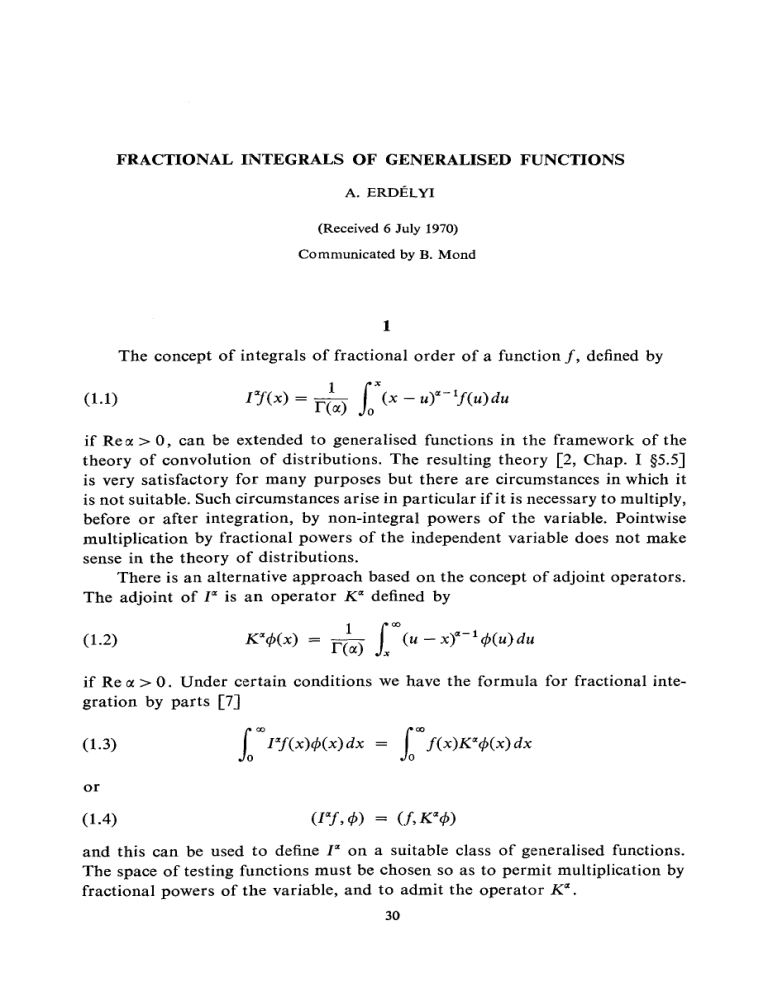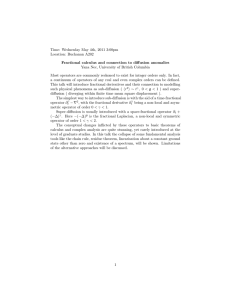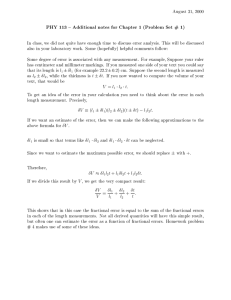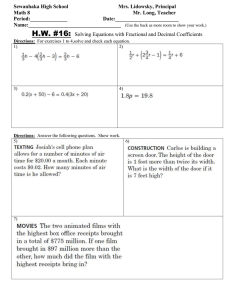
FRACTIONAL INTEGRALS OF GENERALISED FUNCTIONS
A. ERDELYI
(Received 6 July 1970)
Communicated by B. Mond
The concept of integrals of fractional order of a function / , defined by
=
if Re a > 0, can be extended to generalised functions in the framework of the
theory of convolution of distributions. The resulting theory [2, Chap. I §5.5]
is very satisfactory for many purposes but there are circumstances in which it
is not suitable. Such circumstances arise in particular if it is necessary to multiply,
before or after integration, by non-integral powers of the variable. Pointwise
multiplication by fractional powers of the independent variable does not make
sense in the theory of distributions.
There is an alternative approach based on the concept of adjoint operators.
The adjoint of F is an operator K" denned by
(1.2)
K'tKx) = j
if Re a > 0. Under certain conditions we have the formula for fractional integration by parts [7]
(1.3)
r IJ{x)cj>{x)dx = I™ f(x)K"4>(x)dx
Jo
Jo
or
(1.4)
(/*/,</>) = (f,K*4>)
and this can be used to define F on a suitable class of generalised functions.
The space of testing functions must be chosen so as to permit multiplication by
fractional powers of the variable, and to admit the operator K*.
30
[2]
Fractional integrals
31
This approach was indicated in an earlier paper [1] by the present author
and A. C. McBride and it was carried through there for certain operators of
fractional integration developed, for ordinary functions, by H. Kober [3]. Since
[1] was written, Mr. McBridehas further developed the theory of Kober's operators on certain classes of generalised functions and has also made some applications of it.
In Kobsr's operators, integration and multiplication by powers of x are
balanced in such a manner as to make the operator turn a function that belongs
to Lp(0, oo) into another function of that class. The operator F behaves rather
differently. For it, the behaviour at infinity is irrelevant. It is not necessary for/
to be in L(0, oo), and even if/is integrable at infinity, /"/will in general not have
this property; while on the other hand /"/, for an integrable/, will be better
than integrable at the origin.
Professor E. R. Love [6] has studied the operator I" on classes Qq of functions/for which xqf(x) is integrable on [0,/] for each / > 0. Clearly we must
have q 5j 0 for / " / to exist. Love proves that for fe Qq we have I'fe QE-Rex for
each e > 0 if q = 0, and IxfeQq-Re0C if q < 0 . He has also given [5] corresponding results for K". Furthermore, he made a very careful and detailed
study of the first index law
/ ' / * = I"+f
(1.5)
and of the second index law
(1.6)
Pxfl'=
x~"I~fix~y
<x + fi + y = 0
on the classes Qq.
The aim of this paper is to extend these results to corresponding classes of
generalised functions. One hopes to be able to dispense with the many case
distinctions that are necessary in Qq. As generalised functions are differentiable,
/"/can be defined for all a, and there is no need to make a distinction according
as Re a > 0, = 0, or < 0. Moreover, many of the technical steps are performed
on testing functions that are infinitely differentiable and have compact support;
they require much less justification. Also, the operator F is continuous, and so
certain inequalities are automatically indicated; these inequalities could be but
have not been proved for functions. However, some of the results of the theory
in Qq, often precisely those requiring the most perspicacious analysis, cannot
be expected to be included in the study of spaces of generalised functions. For
instance, f o r / e g , , Ff exists for arbitrary a as a generalised function if q < 0,
and Ff belongs to that space of generalised functions containing Qq~Reot, but it
does not follow that in case also Re a > 0, Ff exists as a function and belongs
to 2 ? - R ea- Thus, the present results, while they go further in some directions
than Love's, do not include the latter.
32
A. Erdelyi
[3]
2
For each real p and positive /, let Jpl be the collection of all those complex
valued infinitely differentiable functions <j) of a positive real variable x which
vanish outside the interval [0, I] and for which, for each non-negative integer k,
(2.1)
ypk{<f>) = sup{x- p + *| <£w(x) |: x > 0}
is finite. As in the case p = 0 [ l ] , */p/endowed with the family {ypk: k = 0,1,2, •••}
of seminorms is a complete countably multinormed space, and for fixed real p
(2.2)
Jp
=
(jJpl
i=i
is a complete strict countable union space. Also, in Zemanian's notation [8,
section 4.2], J c Jfab for a ^ p + 1 and any b.
If p < q, </p => */g and the injection of • / , into ^ p is continuous.
Let a be an arbitrary complex number and a = Re a. The operator x* is
defined on J'p by
One proves as in [1] that x* maps . / p continuously i n t o . / , for any q satisfying
q ^ p + a. The mapping is onto, and in fact an isomorphism, if q = p + a.
The operator D is defined by
and, as yqk{(j)') = y9+iit+i(</>), it maps Jp continuously into Jq with q ^ p — 1.
A counterexample given in [1] can be adapted to show that the mapping is not
onto, not even for q = p — 1.
For <j) e Jpl for some real p and positive / and a = Re a > 0 define K"(j)
by (1.2). If
jj
u-xW(u)du
is integrated by parts, the integrated terms vanish and we have
K*+14>'
= -K*<f>.
This makes it possible to extend the definition of K"4> to all a. For n = 0,1,2, •
and Rea > — n, let
(2.3)
K"4> = (-l)"K0"+"</>(n).
For fixed x, K"(f>(x) is an entire function of a. One also has
(2.4)
DkKx(j) = (-l)"X a + V ( " + " )
= ( - l ) * K a ~ > = KxDk(j)
Rea>
-n.
[4]
Fractional integrals
33
For 4> EJPI , K*<f> is clearly infinitely differentiate for positive x, and vanishes
when x> I. Furthermore,
DkK"<Kx) =
^ ~
and so
•
k
\D
K^(x)\ g j ^ t U ! ^ f
1
'
T(a + n) J;,.
(H-X)-+"-V-*-"«
if 0 < x < J.
As x -»0 + ,
(u - x) 8+ "-V~*~"rfu = x a+p ~*
= 0(1)
(f -
iy+a-1
ifp + a - f c > 0
Consequently, yqk{K*$) < oo for allfcand 4> e Jpl provided either q ^ p + a < 0
o r ^ O < p + flor else q < 0 and p + a = 0 .
We thus see that Kx is a continuous map of </p into </ p+o i f p + a < 0 ,
into Jo if p + a > 0, and into ./_, for each a > 0 i f p + a = 0 .
It follows from (2.3) that
and so
(2.5)
K0(p = <j>.
Next, the first index law for K",
(^Z.OJ
A. A. (p = A. <p
can be proved for any $eC°°]0, oo[ vanishing outside of a compact interval
and for Re a > 0, Re/? > 0 by writing the left hand side as a repeated integral
and interchanging the order of integrations. This relation can then be extended
to all a and j? either by analytic continuation or by employing (2.3) and (2.4).
From (2.5) and (2.6),
(2.7)
K~XK"4> = $
for (j> BJP .
We now turn to what is in effect Kober's operators. Let p , a, x be complex
numbers satisfying p + a + % = 0, set Rep = r, Re a = s, Re x = t, and consider the operators
34
A. Erctelyi
(2.8)
[5]
KpaT = X T / .
Kpat maps J'p into itself if p < t, into . / , if p > t, and into ./,_,, for each E > 0
if p = (.
Kober's operators commute. This was shown in Lp(0, oo) by Kober [3,
theorem 4, second part] and in classes similar to Qq by Love [5, theorem 3].
For the sake of completeness we reproduce the proof here especially since the
justification of the formal operations is easier since all integrals are over a finite
range.
Let X, n, v, p, a, % be complex numbers with % + n + v = p + o + T = 0.
It is sufficient to prove
(2-9)
K^K^
= KXflvKpaz<l>
4>eJp
for Re<r > 0, Re/i > 0; the extension to all <r, /x follows by analytic continuation.
Now
=
J,x ~wru (J. ^-Tw-v
/•OO
=
A{X,n,v;p,(T,T,v,x)(j){v)dv,
Jx
where
T(o)T(n)A(X,n,v; p,a,x; v, x)
JX
Making a change of variable, u = vx/w, the last integral becomes
fV+*+»+P(p_wj'-iw-*-*-p-'(w_xy-V+p+'+yw
Jx
and in view of2 + /i + v = p + cr + T = 0 this is
T(a)r(n)A(p,
<J,X;X,II,V;V,X).
The symmetry of A in the triplets A, n, v and p, <r, T proves (2.9).
The second index law for K",
(2.10)
K"xpKy4> = x~yK~px~''4>,
follows from (2.6) and (2.9).
x + P + y = 0,
<£ e j %
[6]
Fractional integrals
35
We now turn to the space J'p of generalised functions, i.e., the continuous
linear functional on Jp. Love's class Qp can be embedded in J'p. Each / in Qp
defines a linear functional on Jp by the definition
(3.1)
(/,<£) =
rf(x)4>{x)dx.
Jo
The integral exists as a Lebesgue integral over a finite interval. If (f> e Jpl , we have
Jo
xp\f(x)\dx
and so the functional generated by/which we shall also denote by/is continuous.
If p <q, J'pc J'q, and the injection of J'p into J'q which assigns to fej'
the restriction o f / t o Jq is continuous. We also denote by Jf'p the collection of
those generalised functions which belong to fq for each q > p. Clearly f <z J',
and the example /(*) = x~ p log(l/x) shows that J'p^= J'p.
The operators x", D, and F can be defined for our generalised functions by
(3.2)
(x°f,<P) = ( / , * »
(3.3)
(Df,® = -(f,D4>)
(3.4)
(Ff,cj>) = {f,K"<j>).
It follows from the results of section 2 on the operators xx, D, K" on J
that x* is an isomorphism of J'p onto J^p_a for any p; D is a continuous map of
J^p into J^p+1 for any p; and that /"can be defined on ./^ only if p ^ 0, and then
maps J'p into J'p-a if p < 0 into J^l a if p = 0. Moreover, x" is also an algebraic
isomorphism of J'p onto Jp'-a for any p; D is a map of ./p'into ^ + 1 for any
p; and / a a map of </p into J^p_a for p ^ 0.
The first index law can now be stated as
(3.5)
fl"f = Ix+fif.
It holds for all a and J?, with a = Re a, ft = Re/?, if either (i) / e . / p and
p < min(0,a) or (ii) feJp and /> ^ min(0,a). In case (i), both sides of (3.5)
are in J'p_a_b, in case (ii) they are in J'p_a-b. This follows from (2.6) in conjunction with the properties of K".
36
A. Erdelyi
[7]
Love [6] has analysed (3.5) in detail when/e Qq, and it is of interest to see
how far his results can be subsumed under (3.5). Of course, only conditions
on a, P, f can be compared. Love proves that the operations on his functions
result again in functions, and can assign these functions to certain Qq classes,
while (3.5) assert the existence and equality of the two sides only in the sense
of generalized functions.
Inhistheorem 1, Love assumes a > 0, b > 0,feQo. As QO can be embedded
in J'o, this accords well with the condition p ^ min(0,a). Although he does
not state it, it follows from his analysis that both sides of (3.5) are in QE~a-b
for each e > 0, and that both sides are in Qq-a-bif q < Q and feQq. This is again
in accordance with the statement that both sides of (3.5) are in J'p^a_b if
p < min(0,a) and in f'p-a-h if p = min(0,a).
The condition b > 0 is required in Love's work to assure that both sides
are functions that can be formed by using (1.1) as the definition of fractional
integrals.
In theorem 2, Love assumes a rg 0, b > 0, /*/ exists in Qo. Under these
assumptions / = I~\I"f) e J^Jand again p = a ^ min(0,a). In a similar manner
in the two remaining cases of Love's theorems 3 and 4 it can be verified that
his conditions on / are in agreement with (3.5).
Next, we define the operator
(3.6)
Ixfy = xxl"xy,
a + j8 + y = 0
and find that it maps J'p into itself if p < Rey and maps J'p into S'p (and J'p into
itself) if p g Rey. I f 2 + /i + v = p + <r + T = 0, we have
(3.7)
hnvlpatf
=
Iparh.nvf
if either (i) feJ'p, p<Rev and p < Rer when both sides are in J'p, or
(ii) / e / p ' , p ^ Re v, p ^ Ret when both sides are in Jp. The proof follows
from (2.9).
Either (3.7) or (2.10) can be used to prove the second index law in the form
(3.8)
/ V r / ( ; t ) = x~"I~px~yf(x)
a + P+y = 0
valid if either (i) feS'p, p < min(0, — c), when both sides are again in J'p or
( i i ) / e . / p , p ^ min(0,-c), when both sides are in Jp. Here c = Rey.
Again a comparison with Love's results is instructive. In theorem 5 of [6]
Love assumes a > 0, b < 0, c> 0 , / e Q _ c and shows that (3.8) holds a.e., with
both sides in Qe-C for each e > 0 . This corresponds to p = — c and agrees
with our results. The conditions a > 0, b < 0 which do not appear in our work
are needed to insure the existence of/"/and I~fic~rf as integrals. Love also proves
that in case a l s o / e g _ c _ , then both sides of (3.8) are again in 6_ c _,. This is
again in agreement with our work, as p = ~-c — r\< min(0, — c). It can be seen
similarly that Love's theorem 6 is in agreement with our results.
[8]
Fractional integrals
37
In his theorem 7 Love assumes a < 0, b < 0, c > 0 and also that Ff exists
and belongs to Qb (and hence to J'b). It follows t h a t / = r"(I"f) e J'a+b = ./'_ c
and hence (3.8) holds with both sides in JLC. The conditions a < 0, £> < 0 are
not needed for the validity of (3.8) in J ic: they enable Love to prove that actually
both sides exist as functions which are in Qe_c for each e > 0. The further result
that if Ffe Qb_n with n > 0 then both sides of (3.8) are in Qb-n is also in agreement
with our results.
In a similar manner it can be verified that Love's theorems 8-10 are also
in agreement with the results presented here. In each case, some of Love's assumptions insure that p ^ min(0, — c), while others, not appearing above, are needed
to insure that both sides of (3.8) exist as functions in certain Qq classes.
Acknowledgement
This paper was written while I was a Visiting Professor at the University
of Melbourne and owes much to Professor Love's work on fractional integrals.
I should like to express my thanks to Melbourne University for their hospitality
and to Professor Love for stimulating discussions, and also for allowing me to
read his unpublished papers.
A. H.
Note added on 17th May, 1972
Additional material on fractional integrals of generalised functions will be
found in: A. C. McBride "A theory of fractional integration for generalised
functions with applications", Ph.D. Thesis, Edinburgh, 1971.
References
[1] A. Erddlyi and A. C. McBride, 'Fractional integrals of distributions', SIAM J. on Math.
Analysis (1970) 547-557.
[2] I. M. Gelfand and G. E. Shilov, Generalized functions Vol. 1 (Academic Press, New York,
1964).
[3] H. Kober, 'On fractional integrals and derivatives', Quart. J. of Math. (Oxford) 11 (1940),
193-211.
[4] E. R. Love, 'Some integral equations involving hypergeometric functions', Proc. Edinburgh
Math. Soc. (2) 15 (1967), 169-198.
[5] E. R. Love, 'Two more hypergeo metric integral equations', Proc. Cambridge Philos. Soc.
63 (1967), 1055-1076.
[6] E. R. Love, 'Two index laws for fractional integrals and derivatives', to appear in the J. of
Australian Math. Soc.
[7] E. R. Love and L. C. Young, 'On fractional integration by parts', Proc. London Math. Soc.
(2) 44 (1938), 1-28.
[8] A. H. Zemanian, Generalized integral transformations (Interscience Publishers, New York,
1968).
University of Edinburgh and
University of Melbourne






